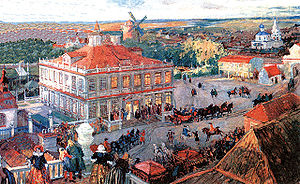
Anna Mons
Encyclopedia

Tsar
Tsar is a title used to designate certain European Slavic monarchs or supreme rulers. As a system of government in the Tsardom of Russia and Russian Empire, it is known as Tsarist autocracy, or Tsarism...
Peter the Great
Peter I of Russia
Peter the Great, Peter I or Pyotr Alexeyevich Romanov Dates indicated by the letters "O.S." are Old Style. All other dates in this article are New Style. ruled the Tsardom of Russia and later the Russian Empire from until his death, jointly ruling before 1696 with his half-brother, Ivan V...
.
Biography
In 1691, during one of his visits to the German QuarterGerman Quarter
German Quarter, also known as the Kukuy Quarter was a neighborhood in the northeast of Moscow, located on the right bank of the Yauza River east of Kukuy Creek , within present-day Basmanny District of Moscow....
, young Peter I of Russia
Peter I of Russia
Peter the Great, Peter I or Pyotr Alexeyevich Romanov Dates indicated by the letters "O.S." are Old Style. All other dates in this article are New Style. ruled the Tsardom of Russia and later the Russian Empire from until his death, jointly ruling before 1696 with his half-brother, Ivan V...
became enamoured of Anna Mons, the daughter of Dutch wine merchant Johann Mon. It is generally thought he was from Westfalia. Her younger brother was Willem Mons (1688-1724), destined to be the Imperial Chamberlain to Catherine Ist and Matrena her sister who married Fedor Balk, Major General and Governor of Riga. Her niece was the infamous Natalia Lopukhina
Natalia Lopukhina
Natalia Fyodorovna Lopukhina was a daughter of Matryona Balk, who was sister of Anna Mons and Willem Mons. She is famous for the Lopukhina Affair, an alleged conspiracy engineered by the diplomacy of Holstein and France at the Russian court and centered on the person of Lopukhina.During the reign...
(1699-1763) later victim of the so called Lopukhina Affair in 1742. As his relations with the tsarina Eudoxia Lopukhina
Eudoxia Lopukhina
Tsarina Evdokiya Feodorovna Lopukhina was the first wife of Peter I of Russia. They married in 1689 but divorced in 1698...
gradually worsened, Anna Mons took the place of his permanent and semi-official mistress. The relationship lasted 12 years.
After Peter divorced Lopukhina, Anna had ambitions of marrying Peter herself, but by 1703 she feared he had lost interest in her and took up a flirtation with the Prussian ambassador Keyserling to rekindle Peter's affections. Keyserling proposed marriage, provoking Peter to have Anna expelled from her estate and put under house arrest with her mother and sister. Peter later allowed the two of them to marry, which they did in 1711. Anna died three years later of consumption
Tuberculosis
Tuberculosis, MTB, or TB is a common, and in many cases lethal, infectious disease caused by various strains of mycobacteria, usually Mycobacterium tuberculosis. Tuberculosis usually attacks the lungs but can also affect other parts of the body...
.
In 1707, Peter I did marry again, to Marta Helena Skowrońska who dyed her hair black so she would not resemble Anna Mons. She later became Catherine I of Russia
Catherine I of Russia
Catherine I , the second wife of Peter the Great, reigned as Empress of Russia from 1725 until her death.-Life as a peasant woman:The life of Catherine I was said by Voltaire to be nearly as extraordinary as that of Peter the Great himself. There are no documents that confirm her origins. Born on...
. Anna's younger brother, Willem Mons
Willem Mons
Willem Mons was the brother of Peter the Great's long-time mistress Anna Mons, who later served as private secretary to his wife Catherine....
, became the Secretary and friends with Catherine. He was an old friend of Peters having taken part in the battle of Poltava. He was charged and executed for abusing his access to the Empress along with his sister Matrena, who was beaten and exiled to Tobolsk, Siberia, and her husband given permission to remarry. The night before the execution Peter told Willem he was sorry to lose such a talented man but he had to execute him. The two were accepting bribes for their influence, according to the favor asked and position of the petitioner, despite having wealth and property laid on them due to their positions. Matrena was later restored to favor by Catherine after the death of Peter, her brothers head in alcohol was put on display in a museum, originally the summer palace of the Tsar and is on display to the present.

